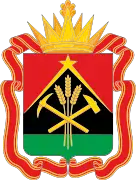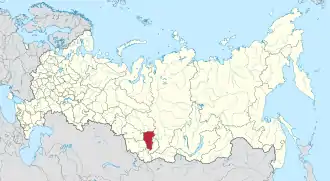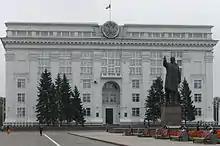Kemerovo Oblast
Kemerovo Oblast (Russian: Ке́меровская о́бласть, Kemerovskaya oblast, pronounced [ˈkʲemʲɪrəfskəjə ˈobləsʲtʲ]), also known as Kuzbass (Кузба́сс) and Kemerovo Oblast — Kuzbass[12] after the Kuznetsk Basin, is a federal subject of Russia (an oblast), located in southwestern Siberia, where the West Siberian Plain meets the South Siberian Mountains. The oblast, which covers an area of 95,500 square kilometers (36,900 sq mi),[7] shares a border with Tomsk Oblast in the north, Krasnoyarsk Krai and the Republic of Khakassia in the east, the Altai Republic in the south, and with Novosibirsk Oblast and Altai Krai in the west. Kemerovo is the administrative center of the oblast, though Novokuznetsk is the largest city in the oblast, in terms of size. Kemerovo Oblast is one of Russia's most urbanized regions, with over 70% of the population living in its nine principal cities. Its ethnic composition is predominantly Russian, but Ukrainians, Tatars, and Chuvash also live in the oblast. The population recorded during the 2010 Census was 2,763,135.[8]
Kemerovo Oblast | |
|---|---|
| Кемеровская область | |
 Coat of arms | |
| Anthem: Anthem of Kemerovo Oblast[1] | |
 | |
| Coordinates: 54°56′N 87°14′E | |
| Country | Russia |
| Federal district | Siberian[2] |
| Economic region | West Siberian[3] |
| Established | January 26, 1943[4] |
| Administrative center | Kemerovo |
| Government | |
| • Body | Council of People's Deputies[5] |
| • Governor[5] | Sergey Tsivilyov[6] |
| Area | |
| • Total | 95,500 km2 (36,900 sq mi) |
| Area rank | 34th |
| Population (2010 Census)[8] | |
| • Total | 2,763,135 |
| • Estimate (2018)[9] | 2,694,877 (−2.5%) |
| • Rank | 15th |
| • Density | 29/km2 (75/sq mi) |
| • Urban | 85.4% |
| • Rural | 14.6% |
| Time zone | UTC+7 (MSK+4 |
| ISO 3166 code | RU-KEM |
| License plates | 42, 142 |
| OKTMO ID | 32000000 |
| Official languages | Russian[11] |
| Website | http://www.ako.ru |
History
The oblast was established on January 26, 1943,[4] but it has considerably older antecedents. Shors, Teleuts and Siberian Tatars are native peoples of the region. The oldest city in Kemerovo Oblast is Novokuznetsk, founded in 1618, soon after Cossack ataman Yermak's push into Siberia.
The territory of modern Kemerovo Oblast has been inhabited for several thousand years. In 1618, Kuznetsk fort was established in the south of the future oblast to protect the land from Russian and Mongolian Dzhungarian invaders. During the 19th century, the territory of the modern oblast was a part of Tomsk Governorate.
Soviet period
After the October Revolution of 1917, Kuzbass experienced significant strife as part of the Russian Civil War. A major peasant rebellion took place in the region in early 1921, but was suppressed by the Red Army.[13] In 1930, Kuzbass became part of the West Siberian Krai, and then the Novosibirsk Oblast. Post revolutionary period was characterized by the transition to a planned economy, the creation of the Ural-Kuzbass industrial complex development of the coal, metallurgical and chemical industries Kuzbass Kemerovo Coke built, Kuznetsk Metallurgical Combine, a lot of new mines. Industrial enterprises are being built near the workers' settlements, which quickly became a city: Kiselevsk Osinniki Krasnobrodsky, Tashtagol Kaltan Mezhdurechensk and others.
During the Great Patriotic War, Kemerovo region became a major supplier of coal and metal. From Novokuznetsk steel produced over 50,000 tanks and 45,000 aircraft. In Kuzbass from the occupied areas were evacuated equipment 71 enterprises, most of which have remained in the Kuzbass.
In January 26, 1943, the Presidium of the USSR Supreme Soviet issued a decree, decided to allocate from the Novosibirsk Oblast of Kuzbass and the establishment on its territory of Kemerovo region with administrative center in the city of Kemerovo. In the new Oblast included 17.5% of the Novosibirsk region, 9 of the 12 cities of regional subordination, 17 of the 20 workers' settlements, 23 of the 75 districts. The population of the Kemerovo Oblast was 42% of the total population of the Novosibirsk Oblast.
Aeroflot Flight 593 crashed into a mountain range in the Kemerovo Oblast in 1994.
Administrative divisions
Climate
The climate of the oblast is continental: winters are cold and long, summers are warm, but short. The average January temperature ranges from −17 to −20 °C (1 to −4 °F), the average in July is 17 to 18 °C (63 to 64 °F). Average annual precipitation ranges from 300 millimeters (12 in) on the plains and the foothills of up to 1,000 millimeters (39 in) or more in mountainous areas. The duration of the frost-free period is 100 days in the north area, and up to 120 days in the south of the Kuznetsk Basin.
Economy
Kemerovo Oblast is one of Russia's most important industrial regions, with some of the world's largest deposits of coal. The south of the region is dominated by metallurgy and the mining industry, as well as mechanical engineering and chemical production. The Evraz Group and an ore subsidiary Evrazruda operate iron ore mining and processing facilities along with the Raspadskaya, Yuzhkuzbassugol, the Siberian holding company SIBPLAZ, coal and coking coal mines there. The northern area of the region is more agricultural. The region has a dense railway network, including the Trans-Siberian Railway, which passes through the oblast. Prokopevsk, Kiselevsk, and Andzhero-Sudzhensk are coal-producing centers, and Novokuznetsk is the center of the engineering industry.
Politics

During the Soviet period, the high authority in the oblast was shared between three persons: The first secretary of the Kemerovo CPSU Committee (who in reality had the biggest authority), the chairman of the oblast Soviet (legislative power), and the Chairman of the oblast Executive Committee (executive power). Since 1991, CPSU lost all the power, and the head of the Oblast administration, and eventually the governor was appointed/elected alongside elected regional parliament.
The Charter of Kemerovo Oblast is the fundamental law of the region. The Legislative Assembly of Kemerovo Oblast is the province's standing legislative (representative) body. The Legislative Assembly exercises its authority by passing laws, resolutions, and other legal acts and by supervising the implementation and observance of the laws and other legal acts passed by it. The highest executive body is the Oblast Government, which includes territorial executive bodies such as district administrations, committees, and commissions that facilitate development and run the day to day matters of the province. The Oblast administration supports the activities of the Governor who is the highest official and acts as guarantor of the observance of the oblast Charter in accordance with the Constitution of Russia.
Honors
A minor planet 2140 Kemerovo discovered in 1970 by Soviet astronomer Tamara Mikhailovna Smirnova is named after Kemerovo Oblast.[14]
Demographics
Population: 2,763,135 (2010 Census);[8] 2,899,142 (2002 Census);[15] 3,176,335 (1989 Census).[16]
Settlements
- Vital statistics for 2012
2009 - 1.67 | 2010 - 1.62 | 2011 - 1.59 | 2012 - 1.76 | 2013 - 1.79 | 2014 - 1.78 | 2015 - 1.71(e)
Ethnic composition (2010):[8]
- Russians - 93.7%
- Tatars - 1.5%
- Ukrainians - 0.8%
- Germans - 0.9%
- others - 1.5%
- 55,899 people were registered from administrative databases, and could not declare an ethnicity. It is estimated that the proportion of ethnicities in this group is the same as that of the declared group.[19]
Religion
As of a 2012 survey[20] 34.1% of the population of Kemerovo Oblast adheres to the Russian Orthodox Church, 7% declares to be nondenominational Christian (excluding the Protestant churches), 3% are members of Rodnovery, the Slavic folk religion, 1% are either believers of Orthodox Christianity not belonging to any church or members of other (non-Russian) Orthodox churches, 1% are Muslims, 5.9% are followers of other religion or people who did not give an answer to the survey. In addition, 31% of the population declares to be "spiritual but not religious" and 17% to be atheist.[20]
See also
 Russia portal
Russia portal Siberia portal
Siberia portal- Geography of South-Central Siberia
- List of Chairmen of the Council of People's Deputies of Kemerovo
References
Notes
- Official website of the Council of People's Deputies of Kemerovo Oblast. Anthem of Kemerovo Oblast Archived June 22, 2013, at the Wayback Machine (in Russian)
- Президент Российской Федерации. Указ №849 от 13 мая 2000 г. «О полномочном представителе Президента Российской Федерации в федеральном округе». Вступил в силу 13 мая 2000 г. Опубликован: "Собрание законодательства РФ", No. 20, ст. 2112, 15 мая 2000 г. (President of the Russian Federation. Decree #849 of May 13, 2000 On the Plenipotentiary Representative of the President of the Russian Federation in a Federal District. Effective as of May 13, 2000.).
- Госстандарт Российской Федерации. №ОК 024-95 27 декабря 1995 г. «Общероссийский классификатор экономических регионов. 2. Экономические районы», в ред. Изменения №5/2001 ОКЭР. (Gosstandart of the Russian Federation. #OK 024-95 December 27, 1995 Russian Classification of Economic Regions. 2. Economic Regions, as amended by the Amendment #5/2001 OKER. ).
- Charter of Kemerovo Oblast, Article 2
- Charter of Kemerovo Oblast, Article 9
- RBC Путин принял отставку Тулеева (in Russian)
- Федеральная служба государственной статистики (Federal State Statistics Service) (May 21, 2004). "Территория, число районов, населённых пунктов и сельских администраций по субъектам Российской Федерации (Territory, Number of Districts, Inhabited Localities, and Rural Administration by Federal Subjects of the Russian Federation)". Всероссийская перепись населения 2002 года (All-Russia Population Census of 2002) (in Russian). Federal State Statistics Service. Retrieved November 1, 2011.
- Russian Federal State Statistics Service (2011). "Всероссийская перепись населения 2010 года. Том 1" [2010 All-Russian Population Census, vol. 1]. Всероссийская перепись населения 2010 года [2010 All-Russia Population Census] (in Russian). Federal State Statistics Service.
- "26. Численность постоянного населения Российской Федерации по муниципальным образованиям на 1 января 2018 года". Federal State Statistics Service. Retrieved January 23, 2019.
- "Об исчислении времени". Официальный интернет-портал правовой информации (in Russian). June 3, 2011. Retrieved January 19, 2019.
- Official throughout the Russian Federation according to Article 68.1 of the Constitution of Russia.
- "Кемеровская область официально стала Кузбассом » Кузбасс главное" (in Russian). Retrieved January 29, 2020.
- "Common Grave of Red Army Soldiers". Kemerovo Oblast. Retrieved July 20, 2019.
- Schmadel, Lutz D. (2003). Dictionary of Minor Planet Names (5th ed.). New York: Springer Verlag. p. 173. ISBN 3-540-00238-3.
- Russian Federal State Statistics Service (May 21, 2004). "Численность населения России, субъектов Российской Федерации в составе федеральных округов, районов, городских поселений, сельских населённых пунктов – районных центров и сельских населённых пунктов с населением 3 тысячи и более человек" [Population of Russia, Its Federal Districts, Federal Subjects, Districts, Urban Localities, Rural Localities—Administrative Centers, and Rural Localities with Population of Over 3,000] (XLS). Всероссийская перепись населения 2002 года [All-Russia Population Census of 2002] (in Russian).
- "Всесоюзная перепись населения 1989 г. Численность наличного населения союзных и автономных республик, автономных областей и округов, краёв, областей, районов, городских поселений и сёл-райцентров" [All Union Population Census of 1989: Present Population of Union and Autonomous Republics, Autonomous Oblasts and Okrugs, Krais, Oblasts, Districts, Urban Settlements, and Villages Serving as District Administrative Centers]. Всесоюзная перепись населения 1989 года [All-Union Population Census of 1989] (in Russian). Институт демографии Национального исследовательского университета: Высшая школа экономики [Institute of Demography at the National Research University: Higher School of Economics]. 1989 – via Demoscope Weekly.
- Естественное движение населения в разрезе субъектов Российской Федерации. Gks.ru. Retrieved on 2013-08-20.
- Каталог публикаций::Федеральная служба государственной статистики. Gks.ru (2010-05-08). Retrieved on 2013-08-20.
- Перепись-2010: русских становится больше. Perepis-2010.ru (2011-12-19). Retrieved on 2013-08-20.
- "Arena: Atlas of Religions and Nationalities in Russia". Sreda, 2012.
- 2012 Arena Atlas Religion Maps. "Ogonek", № 34 (5243), 27/08/2012. Retrieved 21/04/2017. Archived.
Sources
- Законодательное Собрание Кемеровской области. №10-ОЗ 5 июня 1997 г. «Устав Кемеровской области», в ред. Закона №65-ОЗ от 8 июля 2015 г. «О внесении поправки в Устав Кемеровской области». Вступил в силу по истечении 10 дней после официального опубликования. Опубликован: "Кузбасс", №102, 11 июня 1997 г. (Legislative Assembly of Kemerovo Oblast. #10-OZ June 5, 1997 Charter of Kemerovo Oblast, as amended by the Law #65-OZ of July 8, 2015 On Amending the Charter of Kemerovo Oblast. Effective as of the day which is 10 days after the official publication.).
External links
| Wikimedia Commons has media related to Kemerovo Oblast. |
- (in Russian) Informational website of Kemerovo Oblast
